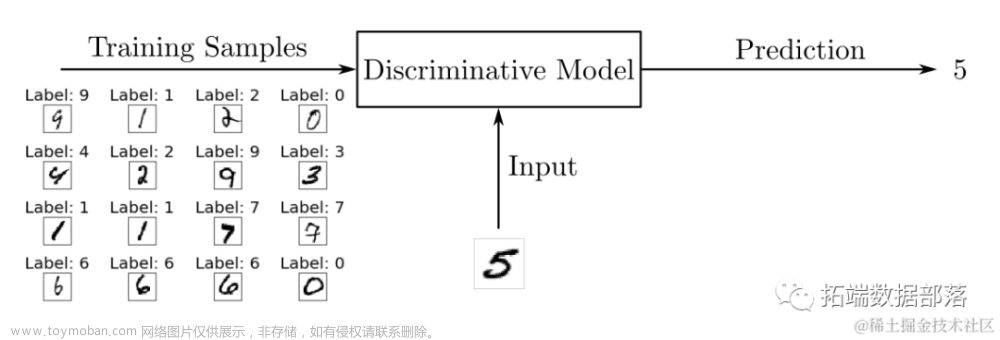这是pytorch官网的示例,记录训练GAN生成牙刷的过程,最终生成器生成牙刷的图像已经可以比较好了。
from __future__ import print_function
#%matplotlib inline
import argparse
import os
import random
import torch
import torch.nn as nn
import torch.nn.parallel
import torch.backends.cudnn as cudnn
import torch.optim as optim
import torch.utils.data
import torchvision.datasets as dset
import torchvision.transforms as transforms
import torchvision.utils as vutils
import numpy as np
import matplotlib.pyplot as plt
import matplotlib.animation as animation
from IPython.display import HTML
# Set random seed for reproducibility
manualSeed = 999
#manualSeed = random.randint(1, 10000) # use if you want new results
print("Random Seed: ", manualSeed)
random.seed(manualSeed)
torch.manual_seed(manualSeed)
定义一些参数
# Root directory for dataset
dataroot = "data/celeba"
# Number of workers for dataloader
workers = 2
# Batch size during training
batch_size = 8
# Spatial size of training images. All images will be resized to this
# size using a transformer.
image_size = 64
# Number of channels in the training images. For color images this is 3
nc = 3
# Size of z latent vector (i.e. size of generator input)
nz = 100
# Size of feature maps in generator
ngf = 64
# Size of feature maps in discriminator
ndf = 64
# Number of training epochs
num_epochs = 30
# Learning rate for optimizers
lr = 0.005
# Beta1 hyperparam for Adam optimizers
beta1 = 0.5
# Number of GPUs available. Use 0 for CPU mode.
ngpu = 1
数据加载类
class ChipDatasets(Dataset):
def __init__(self, root,image_transforms=None,size=(128,128)):
"""__init__ _summary_
Args:
root (str): 数据路径
transforms (_type_, optional): _description_. Defaults to None.
size (tuple, optional): size=(width,height). Defaults to (256,128).
"""
#初始化
self.root = root # root下面就是图片
self.image_paths = self.get_all_images(root)
self.image_transforms = image_transforms
self.label_transforms = transforms.Compose([transforms.ToPILImage(),transforms.ToTensor()])
self.h = size[1] # size=(width,height)
self.w = size[0] # size=(width,height)
def get_all_images(self,root):
image_externs = ["bmp","png","jpg","jpeg"]
image_paths = []
for item in os.listdir(root):
item_extern = item.rsplit(".",1)[-1]
if str(item_extern).lower() in image_externs:
image_paths.append(os.path.join(root,item))
return image_paths
def __len__(self):
return len(self.image_paths)
def __getitem__(self, idx):
image = cv.imread(self.image_paths[idx])
image = cv.cvtColor(image,cv.COLOR_BGR2RGB) # 为了tensorboard显示的时候正常所以采用RGB格式
#这里需要resize,因为用Dataloader加载的同一个batch里面的图片大小需要一样
h,w = image.shape[:2]
if h!= self.h or w!= self.w:
image = cv.resize(image,(self.w, self.h))
# prepare the input
# defect_image = self.create_defect_image(image) # 对输入数据加破损
defect_image = image #
defect_image = torch.tensor(defect_image)
defect_image_chw = defect_image.permute(2,0,1) # 从HWC转为CHW
if self.image_transforms is None:
input = self.label_transforms(defect_image_chw)
else:
input = self.image_transforms(defect_image_chw)
# prepare the label
label_tensor = torch.tensor(image)
label_tensor = label_tensor.permute(2,0,1)
label = self.label_transforms(label_tensor)
return input,label
创建dataset和dataloader
import importlib
import my_encoder
importlib.reload(my_encoder)
from my_encoder import AutoEncoder, DecoderStraight,Encoder,ChipDatasets,SSIM
# We can use an image folder dataset the way we have it setup.
# Create the dataset
# dataset = dset.ImageFolder(root=dataroot,
# transform=transforms.Compose([
# transforms.Resize(image_size),
# transforms.CenterCrop(image_size),
# transforms.ToTensor(),
# transforms.Normalize((0.5, 0.5, 0.5), (0.5, 0.5, 0.5)),
# ]))
dataset = ChipDatasets(r"H:\imageData\MVTec\hazelnut\good",None,size=(64,64))
# Create the dataloader
dataloader = torch.utils.data.DataLoader(dataset, batch_size=batch_size,
shuffle=True, num_workers=workers)
# Decide which device we want to run on
device = torch.device("cuda:0" if (torch.cuda.is_available() and ngpu > 0) else "cpu")
# Plot some training images
real_batch = next(iter(dataloader))
plt.figure(figsize=(8,8))
plt.axis("off")
plt.title("Training Images")
plt.imshow(np.transpose(vutils.make_grid(real_batch[0].to(device)[:64], padding=2, normalize=True).cpu(),(1,2,0)))

模型权重的初始化函数
# custom weights initialization called on netG and netD
def weights_init(m):
classname = m.__class__.__name__
if classname.find('Conv') != -1:
nn.init.normal_(m.weight.data, 0.0, 0.02)
elif classname.find('BatchNorm') != -1:
nn.init.normal_(m.weight.data, 1.0, 0.02)
nn.init.constant_(m.bias.data, 0)
定义生成器
# Generator Code
class Generator(nn.Module):
def __init__(self, ngpu):
super(Generator, self).__init__()
self.ngpu = ngpu
self.main = nn.Sequential(
# input is Z, going into a convolution
nn.ConvTranspose2d( nz, ngf * 8, 4, 1, 0, bias=False),
nn.BatchNorm2d(ngf * 8),
nn.ReLU(True),
# state size. (ngf*8) x 4 x 4
nn.ConvTranspose2d(ngf * 8, ngf * 4, 4, 2, 1, bias=False),
nn.BatchNorm2d(ngf * 4),
nn.ReLU(True),
# state size. (ngf*4) x 8 x 8
nn.ConvTranspose2d( ngf * 4, ngf * 2, 4, 2, 1, bias=False),
nn.BatchNorm2d(ngf * 2),
nn.ReLU(True),
# state size. (ngf*2) x 16 x 16
nn.ConvTranspose2d( ngf * 2, ngf, 4, 2, 1, bias=False),
nn.BatchNorm2d(ngf),
nn.ReLU(True),
# state size. (ngf) x 32 x 32
nn.ConvTranspose2d( ngf, nc, 4, 2, 1, bias=False),
nn.Tanh()
# state size. (nc) x 64 x 64
)
def forward(self, input):
return self.main(input)
验证生成器是否正确
# Create the generator
netG = Generator(ngpu).to(device)
# Handle multi-gpu if desired
if (device.type == 'cuda') and (ngpu > 1):
netG = nn.DataParallel(netG, list(range(ngpu)))
# Apply the weights_init function to randomly initialize all weights
# to mean=0, stdev=0.02.
netG.apply(weights_init)
# Print the model
print(netG)
Generator(
(main): Sequential(
(0): ConvTranspose2d(100, 512, kernel_size=(4, 4), stride=(1, 1), bias=False)
(1): BatchNorm2d(512, eps=1e-05, momentum=0.1, affine=True, track_running_stats=True)
(2): ReLU(inplace=True)
(3): ConvTranspose2d(512, 256, kernel_size=(4, 4), stride=(2, 2), padding=(1, 1), bias=False)
(4): BatchNorm2d(256, eps=1e-05, momentum=0.1, affine=True, track_running_stats=True)
(5): ReLU(inplace=True)
(6): ConvTranspose2d(256, 128, kernel_size=(4, 4), stride=(2, 2), padding=(1, 1), bias=False)
(7): BatchNorm2d(128, eps=1e-05, momentum=0.1, affine=True, track_running_stats=True)
(8): ReLU(inplace=True)
(9): ConvTranspose2d(128, 64, kernel_size=(4, 4), stride=(2, 2), padding=(1, 1), bias=False)
(10): BatchNorm2d(64, eps=1e-05, momentum=0.1, affine=True, track_running_stats=True)
(11): ReLU(inplace=True)
(12): ConvTranspose2d(64, 3, kernel_size=(4, 4), stride=(2, 2), padding=(1, 1), bias=False)
(13): Tanh()
)
)
定义判别器
class Discriminator(nn.Module):
def __init__(self, ngpu):
super(Discriminator, self).__init__()
self.ngpu = ngpu
self.main = nn.Sequential(
# input is (nc) x 64 x 64
nn.Conv2d(nc, ndf, 4, 2, 1, bias=False),
nn.LeakyReLU(0.2, inplace=True),
# state size. (ndf) x 32 x 32
nn.Conv2d(ndf, ndf * 2, 4, 2, 1, bias=False),
nn.BatchNorm2d(ndf * 2),
nn.LeakyReLU(0.2, inplace=True),
# state size. (ndf*2) x 16 x 16
nn.Conv2d(ndf * 2, ndf * 4, 4, 2, 1, bias=False),
nn.BatchNorm2d(ndf * 4),
nn.LeakyReLU(0.2, inplace=True),
# state size. (ndf*4) x 8 x 8
nn.Conv2d(ndf * 4, ndf * 8, 4, 2, 1, bias=False),
nn.BatchNorm2d(ndf * 8),
nn.LeakyReLU(0.2, inplace=True),
# state size. (ndf*8) x 4 x 4
nn.Conv2d(ndf * 8, 1, 4, 1, 0, bias=False),
nn.Sigmoid()
)
def forward(self, input):
return self.main(input)
验证判别器是否正确
# Create the Discriminator
netD = Discriminator(ngpu).to(device)
# Handle multi-gpu if desired
if (device.type == 'cuda') and (ngpu > 1):
netD = nn.DataParallel(netD, list(range(ngpu)))
# Apply the weights_init function to randomly initialize all weights
# to mean=0, stdev=0.2.
netD.apply(weights_init)
# Print the model
print(netD)
Discriminator(
(main): Sequential(
(0): Conv2d(3, 64, kernel_size=(4, 4), stride=(2, 2), padding=(1, 1), bias=False)
(1): LeakyReLU(negative_slope=0.2, inplace=True)
(2): Conv2d(64, 128, kernel_size=(4, 4), stride=(2, 2), padding=(1, 1), bias=False)
(3): BatchNorm2d(128, eps=1e-05, momentum=0.1, affine=True, track_running_stats=True)
(4): LeakyReLU(negative_slope=0.2, inplace=True)
(5): Conv2d(128, 256, kernel_size=(4, 4), stride=(2, 2), padding=(1, 1), bias=False)
(6): BatchNorm2d(256, eps=1e-05, momentum=0.1, affine=True, track_running_stats=True)
(7): LeakyReLU(negative_slope=0.2, inplace=True)
(8): Conv2d(256, 512, kernel_size=(4, 4), stride=(2, 2), padding=(1, 1), bias=False)
(9): BatchNorm2d(512, eps=1e-05, momentum=0.1, affine=True, track_running_stats=True)
(10): LeakyReLU(negative_slope=0.2, inplace=True)
(11): Conv2d(512, 1, kernel_size=(4, 4), stride=(1, 1), bias=False)
(12): Sigmoid()
)
)
定义损失函数
# Initialize BCELoss function
criterion = nn.BCELoss()
# Create batch of latent vectors that we will use to visualize
# the progression of the generator
fixed_noise = torch.randn(64, nz, 1, 1, device=device)
# Establish convention for real and fake labels during training
real_label = 1.
fake_label = 0.
训练
对GAN网络的训练是一个比较玄学的过程,当不收敛的时候调整学习率多尝试几次,或者动态的调整学习率。
# Training Loop
# Lists to keep track of progress
img_list = []
G_losses = []
D_losses = []
iters = 0
# Number of training epochs
num_epochs = 150
# Learning rate for optimizers
lr = 0.005
# Beta1 hyperparam for Adam optimizers
beta1 = 0.5
# Setup Adam optimizers for both G and D
optimizerD = optim.Adam(netD.parameters(), lr=lr, betas=(beta1, 0.999))
optimizerG = optim.Adam(netG.parameters(), lr=lr, betas=(beta1, 0.999))
print("Starting Training Loop...")
# For each epoch
for epoch in range(num_epochs):
# For each batch in the dataloader
for i, data in enumerate(dataloader, 0):
############################
# (1) Update D network: maximize log(D(x)) + log(1 - D(G(z)))
###########################
## Train with all-real batch
netD.zero_grad()
# Format batch
real_cpu = data[0].to(device)
b_size = real_cpu.size(0)
label = torch.full((b_size,), real_label, dtype=torch.float, device=device)
# Forward pass real batch through D
output = netD(real_cpu).view(-1)
# Calculate loss on all-real batch
errD_real = criterion(output, label)
# Calculate gradients for D in backward pass
errD_real.backward()
D_x = output.mean().item()
## Train with all-fake batch
# Generate batch of latent vectors
noise = torch.randn(b_size, nz, 1, 1, device=device)
# Generate fake image batch with G
fake = netG(noise)
label.fill_(fake_label)
# Classify all fake batch with D
output = netD(fake.detach()).view(-1)
# Calculate D's loss on the all-fake batch
errD_fake = criterion(output, label)
# Calculate the gradients for this batch, accumulated (summed) with previous gradients
errD_fake.backward()
D_G_z1 = output.mean().item()
# Compute error of D as sum over the fake and the real batches
errD = errD_real + errD_fake
# Update D
optimizerD.step()
############################
# (2) Update G network: maximize log(D(G(z)))
###########################
netG.zero_grad()
label.fill_(real_label) # fake labels are real for generator cost
# Since we just updated D, perform another forward pass of all-fake batch through D
output = netD(fake).view(-1)
# Calculate G's loss based on this output
errG = criterion(output, label)
# Calculate gradients for G
errG.backward()
D_G_z2 = output.mean().item()
# Update G
optimizerG.step()
# Output training stats
if i % 50 == 0:
print('[%d/%d][%d/%d]\tLoss_D: %.4f\tLoss_G: %.4f\tD(x): %.4f\tD(G(z)): %.4f / %.4f'
% (epoch, num_epochs, i, len(dataloader),
errD.item(), errG.item(), D_x, D_G_z1, D_G_z2))
# Save Losses for plotting later
G_losses.append(errG.item())
D_losses.append(errD.item())
# Check how the generator is doing by saving G's output on fixed_noise
if (iters % 100 == 0) or ((epoch == num_epochs-1) and (i == len(dataloader)-1)):
with torch.no_grad():
fake = netG(fixed_noise).detach().cpu()
img_list.append(vutils.make_grid(fake, padding=2, normalize=True))
iters += 1
Starting Training Loop...
[0/50][0/49] Loss_D: 1.0907 Loss_G: 29.8247 D(x): 0.4985 D(G(z)): 0.2701 / 0.0000
[1/50][0/49] Loss_D: 100.0000 Loss_G: 0.0000 D(x): 1.0000 D(G(z)): 1.0000 / 1.0000
[2/50][0/49] Loss_D: 100.0000 Loss_G: 0.0000 D(x): 1.0000 D(G(z)): 1.0000 / 1.0000
[3/50][0/49] Loss_D: 100.0000 Loss_G: 0.0000 D(x): 1.0000 D(G(z)): 1.0000 / 1.0000
[4/50][0/49] Loss_D: 100.0000 Loss_G: 0.0000 D(x): 1.0000 D(G(z)): 1.0000 / 1.0000
[5/50][0/49] Loss_D: 100.0000 Loss_G: 0.0000 D(x): 1.0000 D(G(z)): 1.0000 / 1.0000
[6/50][0/49] Loss_D: 100.0000 Loss_G: 0.0000 D(x): 1.0000 D(G(z)): 1.0000 / 1.0000
[7/50][0/49] Loss_D: 100.0000 Loss_G: 0.0000 D(x): 1.0000 D(G(z)): 1.0000 / 1.0000
[8/50][0/49] Loss_D: 100.0000 Loss_G: 0.0000 D(x): 1.0000 D(G(z)): 1.0000 / 1.0000
[9/50][0/49] Loss_D: 100.0000 Loss_G: 0.0000 D(x): 1.0000 D(G(z)): 1.0000 / 1.0000
[10/50][0/49] Loss_D: 100.0000 Loss_G: 0.0000 D(x): 1.0000 D(G(z)): 1.0000 / 1.0000
[11/50][0/49] Loss_D: 100.0000 Loss_G: 0.0000 D(x): 1.0000 D(G(z)): 1.0000 / 1.0000
输入一个随机值查看GAN生成器生成的效果
noise = torch.randn(b_size, nz, 1, 1, device=device)
fake = netG(noise).detach()
plt.imshow(np.transpose(vutils.make_grid(fake[0].to(device)[:64], padding=5, normalize=True).cpu(),(1,2,0)))

查看真实样本中图片
real_batch = next(iter(dataloader))
plt.imshow(np.transpose(vutils.make_grid(real_batch[0][2].to(device)[:64], padding=5, normalize=True).cpu(),(1,2,0)))

查看训练过程中生成器和判别器的损失
plt.figure(figsize=(10,5))
plt.title("Generator and Discriminator Loss During Training")
plt.plot(G_losses,label="G")
plt.plot(D_losses,label="D")
plt.xlabel("iterations")
plt.ylabel("Loss")
plt.legend()
plt.show()

生成器在不同阶段生成的效果
fig = plt.figure(figsize=(8,8))
plt.axis("off")
ims = [[plt.imshow(np.transpose(i,(1,2,0)), animated=True)] for i in img_list]
ani = animation.ArtistAnimation(fig, ims, interval=1000, repeat_delay=1000, blit=True)
HTML(ani.to_jshtml())

对比真实数据和fake数据
# Grab a batch of real images from the dataloader
real_batch = next(iter(dataloader))
# Plot the real images
plt.figure(figsize=(15,15))
plt.subplot(1,2,1)
plt.axis("off")
plt.title("Real Images")
plt.imshow(np.transpose(vutils.make_grid(real_batch[0].to(device)[:64], padding=5, normalize=True).cpu(),(1,2,0)))
# Plot the fake images from the last epoch
plt.subplot(1,2,2)
plt.axis("off")
plt.title("Fake Images")
plt.imshow(np.transpose(img_list[-1],(1,2,0)))
plt.show()
 文章来源:https://www.toymoban.com/news/detail-406021.html
文章来源:https://www.toymoban.com/news/detail-406021.html
结论
从上面的结果来看,对于生成牙刷这样的场景这个很小的GAN网络已经可以完成的很好了。文章来源地址https://www.toymoban.com/news/detail-406021.html
到了这里,关于基于GAN的图像生成模型的文章就介绍完了。如果您还想了解更多内容,请在右上角搜索TOY模板网以前的文章或继续浏览下面的相关文章,希望大家以后多多支持TOY模板网!












